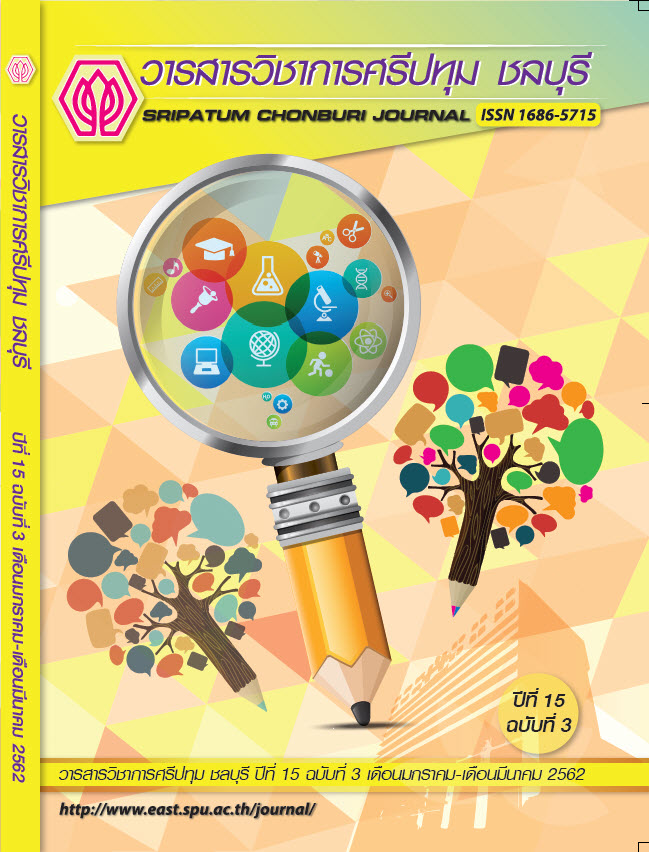A DEVELOPMENT OF OPEN DIGITAL LEARNING REPUBLIC FOR TEACHING AND LEARNING IN 21ST CENTURY SKILLS
Keywords:
the open digital learning republic, 21st century skills, learning innovationAbstract
The objectives of this research were: 1) to develop the open digital learning republic for teaching and learning in 21st century skills, 2) to evaluate the open digital learning republic for teaching and learning in 21st century skills, and 3) to study the satisfaction of students towards the open digital learning republic for teaching and learning in 21st century skills. The samples of the study comprised of 97 students from School of Information Technology and School of Communication Arts, Sripatum University–Chonburi Campus, Thailand. The sample was obtained by cluster random sampling. Research methods were applied to collect quantitative data using interviews and questionnaires for participant and non-participant observations, as well as documentary studies. The data collection was done by questionnaires then the questionnaires were analyzed to find out the conclusion. The data analysis was done using mean and standard deviation. The results indicated that the open digital learning republic for teaching and learning in 21st century skills has been developed and implemented according to high quality of principles and activity processes. The result of students’ satisfaction towards the open digital learning republic was at a good level ( = 4.11, SD = 0.59). This can be concluded that the developed system can be utilized for this course.
References
บทเรียนคอมพิวเตอร์การสอนสำหรับ e-Learning. กรุงเทพฯ: ศูนย์สื่อเสริมกรุงเทพ.
รุ่ง แก้วแดง. (2543). ปฏิวัติการศึกษาไทย (พิมพ์ครั้งที่ 8). กรุงเทพฯ: มติชน.
วราภรณ์ ตระกูลสฤษดิ์. (2545). จิตวิทยาการปรับตัว (พิมพ์ครั้งที่ 2). กรุงเทพฯ: ศูนย์ส่งเสริมวิชาการ.
สุวิทย์ มูลคํา และอรทัย มูลคํา. (2551). 19 วิธีจัดการเรียนรู้ เพื่อพัฒนาความรู้และทักษะ (พิมพ์ครั้งที่ 7).
กรุงเทพฯ: โรงพิมพ์ภาพพิมพ์.
อุบลลักษณ์ ไชยชนะ. (2542). การศึกษาความสัมพันธ์ระหว่างความพึงพอใจในการเรียนกับความ สอดคล้องในการเลือกคณะของนักศึกษามหาวิทยาลัยเชียงใหม่. วิทยานิพนธ์การศึกษามหาบัณฑิต สาขาวิชาจิตวิทยาการแนะแนว, บัณฑิตวิทยาลัย มหาวิทยาลัยศรีนครินทรวิโรฒ.
Bloom, Benjamin S. (1984). Taxonomy of educational objectives: The classification goals handbook 1
cognitive domain. New York, NY: Longman.
Gaines, Elliot. (2002). Building community through stories about real events: The habitus of broadcast
journalism (Online). Available: http://www.wright.edu/~elliot.gaines/BuildingComm.htm [2015, June 5].
International Organization for Standardization. (1998). ISO 9241-11 Ergonomic requirements for office work with visual display terminals (VTDs) – Part 11: Guidance on usability (Online).
Available: https://www.iso.org/obp/ui/#iso:std:iso:9241:-11:ed-1:v1:en [2015, June 16].
_______. (2006). ISO 9241-110 Ergonomics of human-system interaction – Part 110: Dialogue principles (Online). Available: https://www.iso.org/obp/ui/#iso:std:iso:9241:-110:ed-1:v1:en
[2015, June 16].
Yamane, Taro. (1967). Statistics: An introductory analysis (2nd ed). New York, NY: Harper.
Downloads
Published
Issue
Section
License
บทความทุกบทความเป็นลิขสิทธิ์ของวารสารวิชาการศรีปทุม ชลบุรี



